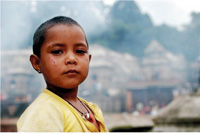Children of God
Pashupatinath, Nepal, is the largest sacred ground for the Hindus. At the crematory near the Bagmati (the holy river that crosses the Pashupatinath) they perform a daily ritual that involves burning the bodies with fire. This ritual sends the dead to the heavens. As the fire and ash rise up from the cremation site, children swim in the river looking for coins or money that was left with the burned bodies.
Where there is life, there is death. At the crematory by the Bagmati River is the holy pilgrimage site of Pashupatinath in Kathmandu, the capital of Nepal. There are people whose livelihoods depend on the ritual of death. At the crematory, children live off the food and money used in funeral ceremonies drifting in the river. The children, who are around 10 years old, are more than willing to jump into the river to make a mere 10 rupees. The Bagmati riverside is a holy ground and a crematory for the Hindus, but to children this place is a playground, a home, and their workplace. Some children who cannot stand living in poverty at the crematory go out to the city and beg drivers in the middle of the road to make more money. The children may make more money panhandling in the city, but they are exposed to the danger of getting hit by cars and are likely to turn to cigarettes and glue-sniffing. The government and grown-ups do not look after these children who beg in the city and at the riverside crematory. Religious rituals are performed for the dead, but not for the living children with innocent eyes. Nobody respects the rights of the children in this place. Children of God takes an in-depth look at the children of Nepal who struggle just to stay alive. Their innocent eyes, and the cheerful yet sorrowful songs, make the audience think of God’s benediction and God’s abandonment at the same time.
Visit: Nepal Startpagina, Tibet Startpagina, Bhutan Startpagina, Himalaya Startpagina
Yi Seung- jun
Duration: 90 minutes



